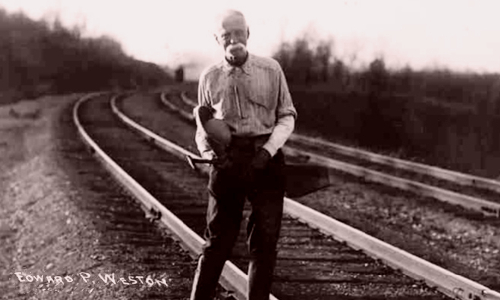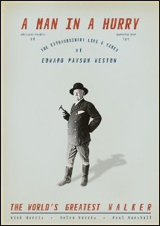The world's greatest walker

There was a time in the Victorian era when long distance races were staged in front of paying crowds of tens of thousands of people. That was when "professional pedestrianism" was in its heyday. And the greatest walker of that heyday – certainly the most flamboyant – was an American called Edward Payson Weston.
His 3,100-mile trek from California to New York, completed on 3 May 1910, was one of his great achievements, but only one. It took him just 77 days. He was 71 years old by then. As the New Hampshire newspaper, "The Daily Herald", reported on 3 May: "Five hundred thousand people crammed New York's greatest thoroughfare today to see one white-haired man march through their cheering lines. The man was Edward P. Weston, and the ovation which he received was the greatest ever accorded to any man not connected with public life."
For half a century Weston had been one of the most famous people in America, indeed in the English speaking world, as the first age of international celebrity unfolded. P.T. Barnum was his contemporary and friend, as were other prominent showmen, musicians, writers, businessmen and politicians.
It was Abraham Lincoln who unknowingly set Weston on the road to fame. Weston lost a bet with a friend on the outcome of the 1860 U.S. Presidential election, which Lincoln won. Weston's forfeit was to walk 478 miles from Boston to Washington to attend Lincoln's inauguration.
He completed the journey in 10 days, and subsequently became a prime mover in pedestrianism, a sport that took the Victorian world by storm. In Weston's athletic career he covered tens of thousands of miles, drawing paying crowds and unscrupulous gamblers alike.
He polarised opinion – "Hero or humbug?" was a recurring theme – but his feats of endurance stunned professional observers. On his first trip to England, in 1876, he brought the astounding properties of cocaine to the attention of a fascinated British medical establishment for the first time.
That episode caused a furore but it was exercise, healthy food, plenty of rest and lashings of whisky (on his feet, not down his throat) that played a greater part in Weston's success than any narcotic.
Weston was monitored by Queen Victoria's physician as he left rivals in his wake. Many were left bloodied and broken by their efforts to match him in races that lasted up to six days and were staged in front of tens of thousands.
After one 5,000-mile walk around Britain in 1884, medics from the Royal Society concluded "his feat is the greatest recorded labour that any human being has ever undertaken without injury".
His private life was no less dramatic, a consequence of a character flawed by the obsessions that drove him. Weston, a.k.a. 'The Wily Wobbler' for his sprightly gait, was a family man, married with three children who doted on him. He was forever concocting schemes to make them rich.
But he was also a dandy, a charmer, a hit with the ladies who flocked to see him. His roving eye eventually led to the break-up of his marriage, to at least one illegitimate child, and to mortal danger. At one stage late in life he survived being shot.
Weston was born in Providence, Rhode Island in the spring of 1839. He was a direct descendant of two Mayflower pilgrims (and as such, related to twenty million contemporary Americans) and kin to the Churchill family of Sir Winston, Princess Diana and numerous European royals.
Weston's father, Silas, was a teacher, merchant and adventurer while his mother, Maria, wrote poetry and novels as well as raising four children. Weston was a small, sickly child who grew into a boy who ran away with a circus, into a teenager who ran his own publishing business and into a man who ran his life on a head full of dreams.
At 21, he struck the bet that altered his destiny. He walked to meet the new President, but Lincoln's inauguration was a catalyst for the four-year American Civil War, an era of upheaval and change, for Weston as for everyone.
He married. He suffered family tragedies. He racked up debts as a hapless businessman, but the lure of a $20,000 prize pot drew him into what would become a lifetime of walking for cash.
In 1867 he walked 1,226 miles from Portland to Chicago in 30 days amid rumors that he was in cahoots with New York gangsters on a massive betting scam. That trek was a rollercoaster of hysteria, death threats, groupies, atrocious weather, riots and glory. Dan Rice, a presidential candidate and a fan, made a cameo appearance as Weston became a household name.
From controversy to curiosity, Weston attempted time and distance records, took on all comers (if the purse was right) and toured America as an exhibitionist. Walking 50 miles in 10 hours plus half a mile backwards was a staple day's showground work.
Critics didn't believe the hype, so Weston responded by walking 100 miles indoors under test conditions, then became the first man to cover 400 miles in five days, and the first to walk 500 miles inside six days.
He did that "magic 500" on a sawdust track at the Newark Rink, New Jersey, in December 1874, eating on the move and snatching sleep in short bursts, as was usual. He ended his task under police guard, fearful of "New York roughs" and corrupt betting syndicates who wanted him to fail.
The six-day race became the blue riband discipline as pedestrianism surged in popularity. At its zenith, when major races attracted dozens of star international entrants, the winner could expect prize money worth the equivalent of up to £250,000 today.
In the rush for kudos and earnings, the major rivalry in Weston's career was with an Irish-American from Chicago, Dan O'Leary, a fast-living hard man who got the better of Weston time and again before the booze got the better of him.
Weston was based in England for eight years from 1876, a year when he turned scepticism to astonishment in his first few weeks in the country. In his debut race, he pulverised the English champion over 24 hours, then thrashed other challengers over 48 hours, 75 hours and six days, and attracted crowds of 200,000 in five weeks.
The British public and press were being spoilt by sporting firsts – Captain Webb had recently become the first man to swim the Channel unaided, and long-distance cycling was in vogue – but Weston's achievements were widely lauded. Even the cocaine scandal led to debate rather than lasting damage to his reputation.
One of Weston's showdowns with O'Leary was in April 1877 at the Agricultural Hall in Islington, London. In attendance was a rich, influential, MP, Sir John Astley, an old Etonian former soldier and runner known for his love of horse racing and boxing, and for being an inveterate gambler.
Sir John lost £20,000 betting on Weston to win that one race alone but he was instantly smitten with pedestrianism and sponsored a series of six-day races for the 'Astley Belt'. Sir John's patronage over several years increased pedestrianism's respectability.
Among Weston's greatest individual triumphs was winning the Astley Belt in 1879 at the age of 40, when he walked a record 550 miles in six days. Not for the first time, it was suggested Weston had helped to 'land a gamble' by losing earlier races to lengthen his odds for a coup in the big one. Not in doubt was his core achievement.
Weston announced his first retirement aged 47 in 1886, but it was neither peaceful nor permanent. His marriage to Maria had often been fraught, tying them together with "shackles they both hated", and Weston walked out for good in 1893, aged 54.
He set up home with a mistress portrayed until his dying day variously as a niece, nurse, secretary or distant younger relative. He also resumed his walking career.
In 1896, aged 57, he tried to replicate a feat of walking 112 miles inside 24 hours, done 22 years earlier. In front of society friends, industrialists, magnates and the president of the New York City police, Theodore Roosevelt, Weston broke down after 103 miles and tearfully declared "I am a fool" and "that to fail breaks my heart".
It did not break his spirit. Age 68, in 1907, he repeated an earlier journey from Portland to Chicago, beating his time of 40 years before. In 1909, on his 70th birthday, he began a 4,000 mile walk from New York to San Francisco, a journey he completed inside 105 days at a time when the record in a motor car was 15 days. In 1910, he walked the other way to be greeted in New York by half a million people.
In his 80s he undertook challenges of up to 500 miles, and at 85 he survived being shot in a raid on his rural home during an incident that was almost certainly related to his love life.
In his final years, broke and increasingly frail, Weston was supported by a trust fund established by a playwright, Anne Nichols. On his 88th birthday, he was still well enough to attend a birthday luncheon hosted by the mayor of New York.
Weston regularly expounded his view that walking was an antidote to a sedentary lifestyle and to the "lazy culture" encouraged by cars. In a cruelly ironic twist, a week after his 88th birthday he was knocked down by a taxi, and never walked again.
When he turned 90in the spring of 1929, Weston, confined to a wheelchair, described the occasion as his "bitterest" birthday, but expressed the hope that he would walk again, when the weather became warmer.
Edward Payson Weston, the world's greatest walker, died on 12 May 1929.
Credits - WorldwideRunning.com would like to thank the website SportIntelligence.com (www.sportingintelligence.com) for the authorization to reprint the article "The world's greatest walker: a Victorian pioneer of ultra-marathons (and coke)" by Paul Marshall and Nick Harris.


